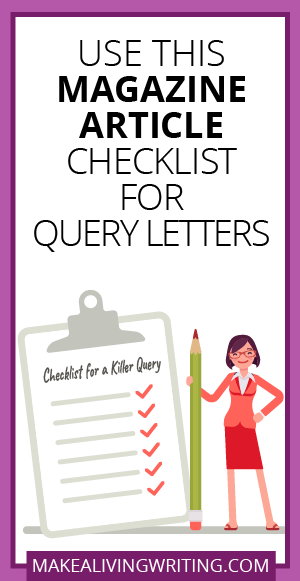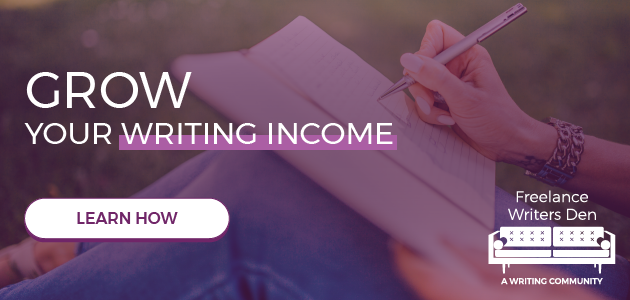 Say you’ve got an idea for a magazine article. You write up a query and send it in.
Say you’ve got an idea for a magazine article. You write up a query and send it in.
What happens next? Crickets.
I’ve heard this tale from hundreds of writers. They all want to know why.
Usually, the answer is that you don’t know how to analyze the magazine you’re pitching, and use what you learn to create the perfect query — the irresistible one that editor can’t resist.
Everything you need to know to write a hot query can be found by studying the articles in that magazine.
What do you need to look for? Here’s my checklist:
Extra, extra
It may seem like a small thing, but knowing how to write a headline that’s in the style of your target magazine can help get you off on the right foot with an editor. It shows you’ve read their magazine and care about their style.
For instance, some magazines have long headlines. Here’s one from O the Oprah Magazine:
This ‘Call Me By Your Name’ Producer is Fighting Female Violence in Film
Other magazines tend to favor short, 2-5 word, punchy headlines. This is usually followed by what editors call a ‘dek,’ that explains the topic in more depth. For instance, here’s the headline for a piece I did for Alaska Beyond:
Market Makers
Investor Appetite is Increasing for Initial Public Offerings
See the difference? Copy the headline style to alert your editor that you’ve read their pub — which makes them want to read through your query more carefully.
In the beginning…
As with headlines, magazines have conventions about how their articles begin (known in journo-speak as ‘the lede’).
Flip through an issue and read the first paragraph of each story. You’ll probably quickly detect a pattern.
It might be that most stories begin with a riveting anecdote. Or they might start with a fresh statistic or recent news event. Perhaps many begin by asking a question (that’s certainly true here on my blog).
Once you get the type of lede they prefer, you can write the lede in your query letter the exact same way.
Boom! The editor starts to imagine your magazine article appearing in the pages of their publication. Because it fits perfectly with their style.
Get to the nut
Most magazine articles have a paragraph early on that sums up what you’re going to learn in the story. It frames why the piece is important, and what news makes it relevant right now.
This paragraph is known to editors as the nut graf. One slick thing you can do analyzing your magazine is to see how far into the story nut grafs appear.
In a long feature, the nut might be a dozen paragraphs in. In some magazines, the nut graf IS the lede. It’s paragraph one. More typically, you’ll find it 3-6 paragraphs in.
Knowing the placement of the nut allows you to build your query so that your nut falls at the right point. In the query, that nut will say something along the lines of:
“In my article, [headline here], readers will learn X…”
It may be a little bit subliminal, but placing the nut in the right spot signals to the editor that you know how tight you need to write this, and how quickly you’ve got to get to the point of the story. Creating a nut also pulls together the drift of your story, so the editor can easily get their head around it and decide if it’s of interest.
When an editor goes searching through your query in vain for the headline and nut graf…they tend to move on.
Find the source(s)
The next step is to see what sort of facts are cited. What makes an acceptable source for this magazine?
Some publications trust government-agency sources. Say, the Bureau of Labor Statistics or the U.S. Census. For trade publications such as Nation’s Restaurant News, a source such as the International Franchise Association will be solid gold.
Still others love recently released survey data from top pollsters such as Gallup or Harris. Medical journals will want studies from highly regarded medical-research institutions.
Match your magazine article’s research sources to the types of sources you see in print, and you’ll convey the right authority vibe to please that editor.
Quotable quotes
Related to sourcing is the issue of interview quotes. Rattling off a statistic is one thing, but who do they find fascinating enough to quote in a story?
In a typical article, you might see a mix of ‘real people’ sources — the mom whose kid committed suicide, for instance — and experts in the topic. Those experts might be academics, association directors, authors, researchers, government officials and more.
Many magazines have rules about who can be quoted, or preferred interview types, and you can divine those by studying the quotes in current issues.
For example: For many years, business-owner sources for Entrepreneur always had to be under age 40, and their businesses had to have at least $1 million in revenue. (I know, like no one older has any knowledge? I had to pass on a lot of great innovators for that mag.)
Their ages were required to be stated, by the first reference of their name. Scanning an issue, this quirk would be apparent pretty quick. Catching on to that sort of detail can help you zero in on ideal interview subjects, save you a lot of wasted time — and impress your editor.
Check the layout
Just as magazines have conventions for headlines, ledes, quotes, and sourcing, they also tend to have article formats they prefer.
Have you read O lately? It’s charticle city there — single-page, often graphically driven pieces with short paragraphs or sentences for each section. If you pitch them a charticle-format magazine article, your odds of acceptance will likely improve.
Other magazines like subheaded sections, or prefer lists of numbered tips. Knowledge of article format can help shape your headline idea, if the magazine editor likes the setup of ‘7 Tips for Better Bread’ more than they would ‘How to Make the Perfect Loaf of Bread.’
Wrap it up
Magazine articles begin…and they also end. How they end is another style point for many magazines, so give a look.
I have a habit of ending articles with a final, insightful quote from one of my sources, which seems to work well for many different types of publications. But study the one you’re targeting.
You may not use it in your query, but you’ll be ready to write your draft when you get an assignment — and having studied your publication in this depth, your odds of that happening have definitely increased.
Watch your tone
Many magazines have a distinctive style. Their word choices stand out. Cosmopolitan is the one that always makes an easy example here. I just went to their site to give you some examples of their tone, and their notifications pop-up said, “Wanna stay on top of all the sh*t you actually care about?”
Obviously, if you’re reading The New Yorker, that’s not going to happen. Tune into word choice in your chosen pub to pick up on how they say stuff. Then, talk their lingo in your query. This is another big way to help the editor envision your piece in their magazine.
Don’t repeat
Many writers make the mistake of flipping through the current issue of a magazine, and then pitching the editor another article on one of the topics they just saw.
That’s not likely to pay off. If a magazine comes out 12 times a year, it’s unlikely they’re going to cover a particular topic more than once in a year. If it’s been 2 years since they did it and you have a fresh angle, you’ve got more of a shot.
Magazine editors are looking for something that’s like what they’ve covered, in terms of general wheelhouse, but that takes a new direction.
So if you see an article in the magazine on preventing teen suicide, for instance, don’t pitch them another one. Even if you found an interesting program for it. Maybe a story on how kids with terminal illnesses are supporting each other, maybe there’s a new app for that?
They also love topic pitches on ideas that are part of their mission, but have been neglected (so be sure to dig for their mission statement).
For instance, AAA magazines get tons of travel pitches — but they also sell insurance, and cover that area. Look for the less-traveled path and give them a story they’re more likely to need.
Imagine the reader
As you’re studying the magazine, a final step is to start imagining the reader of this publication. Who are they? What do they care about?
If you have several different ideas you’ve been considering pitching, honing in on the reader and their problems can probably help you see which one would be the most compelling for that editor.
Write your magazine article query
Once you’ve done all this analysis, you’re ready to cast your idea into the format your editor will love best. Your pitch should include:
- Proposed headline
- Lede
- Nut
- Ideally, a bit of pre-interview from a source (or at least mention of the who you might interview)
- ONE LINE about yourself to conclude, as in, ‘I’m a Seattle-based freelance business writer’
Including these concrete examples of how you’d actually write the story gives the editor a much better idea of whether you can really deliver what they want. Armed with your magazine-article research, you should be able to nail that.
What’s worked for you in writing article queries? Leave a comment and let’s discuss.
The post Magazine Article Tips: Your Fail-Proof Checklist for a Killer Query appeared first on Make A Living Writing.
from Make A Living Writing https://ift.tt/2tx1aby

No comments:
Post a Comment